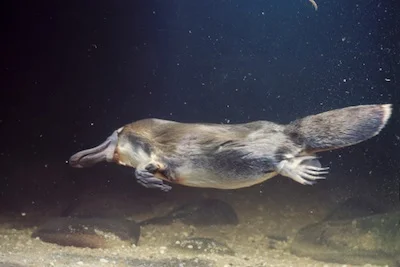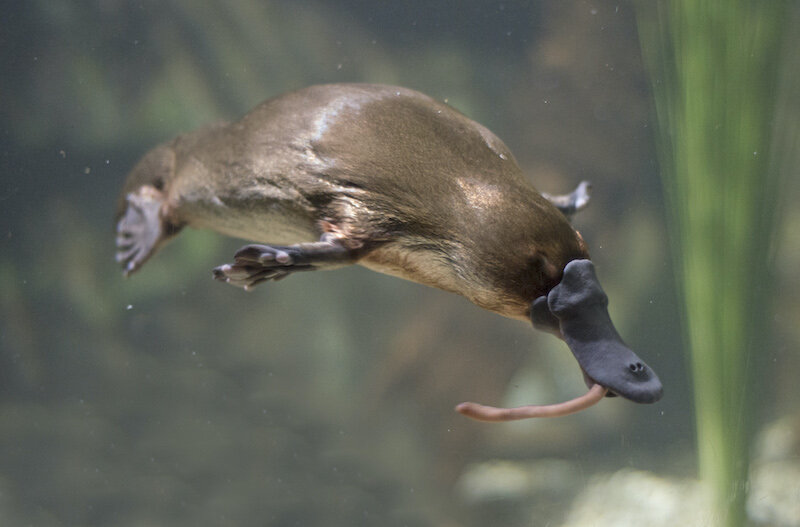A platypus is a strange mixed up animal.
It is kind of mammal called a monotreme
It has webbed feet, a bill like a duck's, and a tail like a beaver's.
The females lay eggs, and after they hatch, they feed their young milk.
Platypuses live near streams and lakes in parts of Australia.
They eat worms and other small animals that live in the water.
What is a platypus?
The platypus is a puzzle! It is a special mammal. It has webbed feet and a bill like a duck's although it is leathery - in fact, they are often referred to as 'duck-billed platypus'. It has a tail that looks a bit like a beaver's, it has fur but lays eggs that look like reptile eggs and it feeds its young on milk like a mammal.
Words for more than one platypus can be either ‘platypuses’ or ‘platypi’ (say plat-ee-pie).
The platypus is a unique animal that confused the first Europeans who came to Australia. When a stuffed platypus was sent to England by early settlers, scientists there thought a trick had been played on them and that parts of several animals had been put together to become a fake animal.
It was many years before scientists could actually classify (put into a group) the platypus. It is a mammal, but in a special group together with the echidna: it's a monotreme, or egg-laying mammal.
Habitat and Distribution (where it is found)
Platypuses live beside freshwater rivers, creeks and lakes in eastern and south- eastern Australia, stretching from Queensland down to Victoria and Tasmania.
Platypus are shy creatures who live beside freshwater habitats in eastern and southeastern Australia.©Getty
They dig long burrows in the bank, with the entrance to the burrows above the water level and well hidden. The entrance to the burrow is tight so that water is squeezed out of the animal’s fur as it enters.
Appearance and behaviours
Platypuses have webbed feet and a broad, flat tail about 12 centimetres long that helps them swim. When they swim, platypuses close their ears and eyes, and stay underwater for about two minutes at a time. They have thick waterproof fur that helps them keep warm, in layers so that their skin doesn't get wet.
Feeding
Platypuses are most often out looking for food before dawn and for a few hours before sunset. However, they are not completely nocturnal and are active for periods during the day. They feed on creatures that live in rivers, creeks and lakes.
With closed eyes because it is underwater, this platypus has just caught a worm. ©Getty
Underwater they close their eyes and feel for food with their leathery bill, which has special nerves in it that sense the movement of prey. The platypus scoops up worms, shrimp, insect larvae and other small water animals.
The food is stored in cheek pouches until the platypus swims to the surface to eat it. When they eat food, platypuses crush it with tough, horny pads on their upper and lower jaws. They don't have teeth.
The body
A platypus' body can be up to 45 centimetres long. They can weigh up to 2.3 kilograms. Males are larger than females.
A platypus swimming at the surface ©Getty Images
The platypus uses its webbed feet for swimming.
On land, the webs turn back to uncover claws on the feet which it uses to dig a long burrow in the banks of rivers and creeks. Some burrows can be as long 25 metres. Each platypus has its own burrow. The opening of the burrow is small, so that the water is squeezed out of the platypus' fur as it enters the burrow.
Males have a poison spur on each back leg. ©Getty
Behind the ankles on each hind leg male platypuses have a sharp, hollow claw-like spur connected to venom (poison) glands.
Male platypuses may use them to protect themselves from predators and to fight other male platypuses during mating season.
The venom is not fatal to humans, although it causes swelling and great pain.
Life cycle
Platypus close eyes and nostrils underwater ©Getty Images
Females build a nest of damp grass and leaves in a chamber at the end of a long nesting burrow when it is time to lay eggs. The dampness helps keep the temperature of the chamber right for the eggs and young. She carries plants from the water's edge by curling her tail around the bundles.
After mating with a male platypus, (between June and October) a female seals herself into the nesting chamber by blocking the entrance with soil and lays one or two eggs. She lies curled up with the eggs between her body and tail to protect them until they hatch. Tiny, naked babies hatch from the eggs after about ten days . They drink milk that oozes from their mother's body, sucking it from her fur. Their sucking is rather like the action of a vacuum cleaner because a female monotreme does not have nipples like other mammals do. The young stay with their mother for up to four months, after which time they can swim on their own and search for food.
The platypus is on one side of the Australian 20c coin. ©Getty Images
Conservation Status and Threats
Platypuses are listed as being of Vulnerable. However, it is very hard to know the numbers of these shy, hard to spot creatures.
It’s a good idea to get information from more than one source!
Read more about the platypus here:
Watch a video showing 10 ‘did you know?’ facts about the platypus
https://www.youtube.com/watch?v=apmfhV_ko0E
Watch a video that includes the rare sight of a newborn platypus inside the nest
https://www.bbc.co.uk/programmes/p004jl2c








